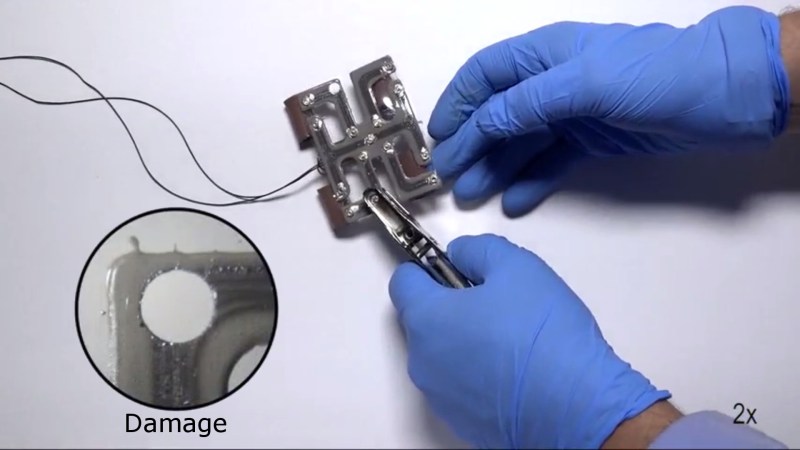For many of us, our first robots, or technical projects, were flimsy ordeals built with cardboard, duct tape, and high hopes. Most of us grow past that scene, and we learn to work supplies which require more than a pair of kitchen scissors. Researchers at Carnegie Mellon University and Iowa State University have made a material which goes beyond durable, it can heal itself when wounded. To a small robot, a standard hole puncher is a dire assailant, but the little guy in the video after the break keeps hopping around despite a couple of new piercings.
The researcher’s goal is to integrate this substance into bio-inspired robots which may come to harm in the field. Fish-like robots could keep swimming after a brush with a bit of coral or a curious predator. Robot snakes could keep slithering after a fall or a gravel road.
Of course, robotic simulacrums are not the only ones who can benefit from healing circuitry. Satellites are prey to punctures from errant space debris.
[Thank you, Qes, for the tip]
















T1000 here we go
Reminds me of insects, there was a SciFi story few decades ago that insects were robots designed by super computers produced by an earlier human like race to ostensibly handle garbage collection and crop management but, got out of hand. Iirc the writer explored Noether’s theorem as part of the design criteria in respect of simplest mechanisms with max range of utility which would have worked fine but, a character in the story messed with the program producing ‘unforseen results’.
IOW. Very simple devices cheap to make can collectively handle complex tasks much like grex like organisation – applies to all multi-cellular life on earth too… Watching how many insects take on emergent behaviours from very simple units adds a perspective towards how a possible Artificial Intelligence could emerge… https://en.wikipedia.org/wiki/Grex_(biology) pl
What part of this involves healing? It’s a robot that continues to hop across the table if you put holes in two very specific spots (and maybe only those spots) but I don’t see any regrowth of material.
The fact that it can form conductive scabs is interesting, but I wouldn’t consider this “healing.” Fault tolerance, at best.
Follow the link to the article… it’s much more descriptive. Basically there is a liquid-filled coating on the material. When a rupture occurs, the liquid flows around the edge of the rupture and re-establishes the electrical connection. Sounds like a great way to let out he magic smoke (cut a power and ground trace with the same break and see what happens). It’s cool, especially for satellites where you don’t get to go out and manually fix problems (usually). But for home robots, you could just take a conductive ink pen and do the same thing.